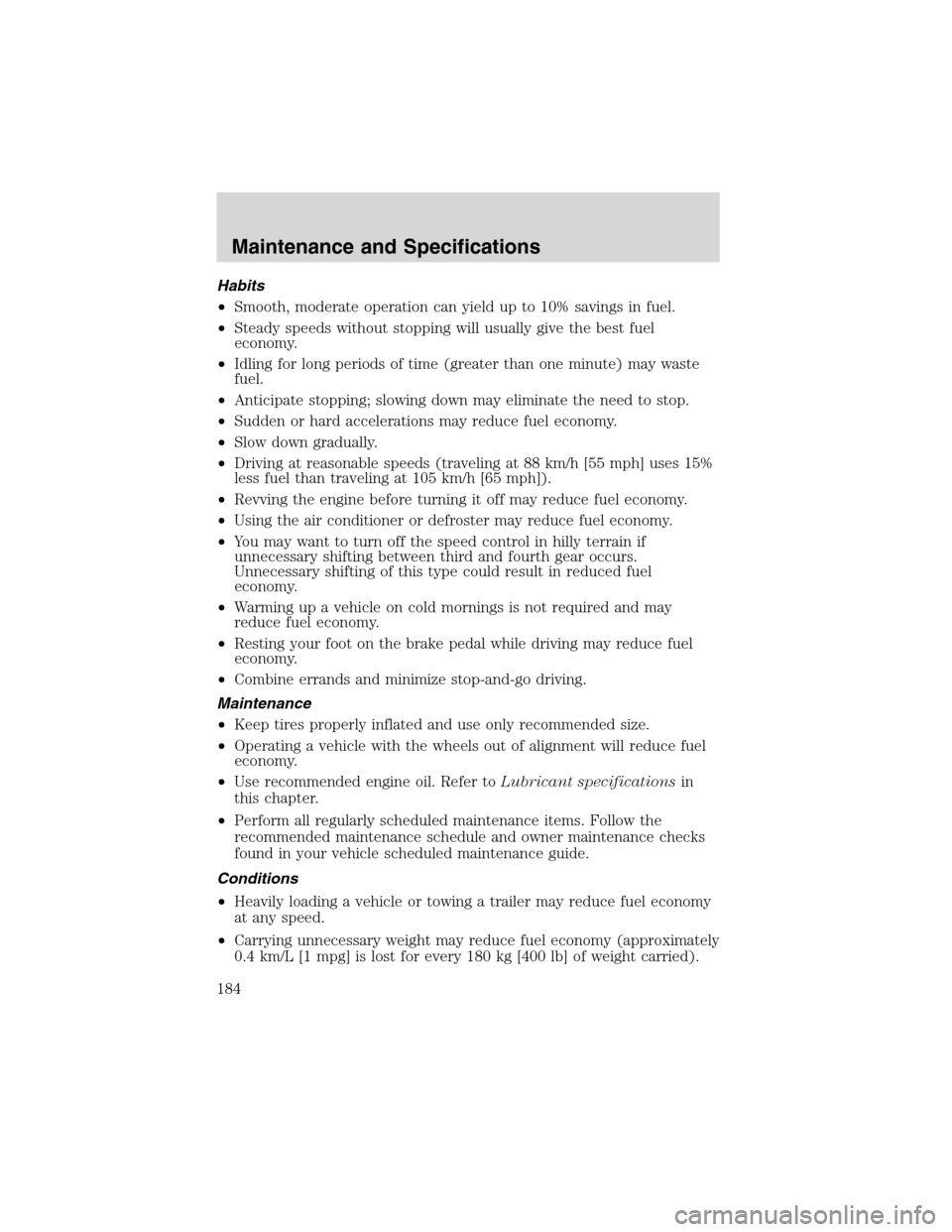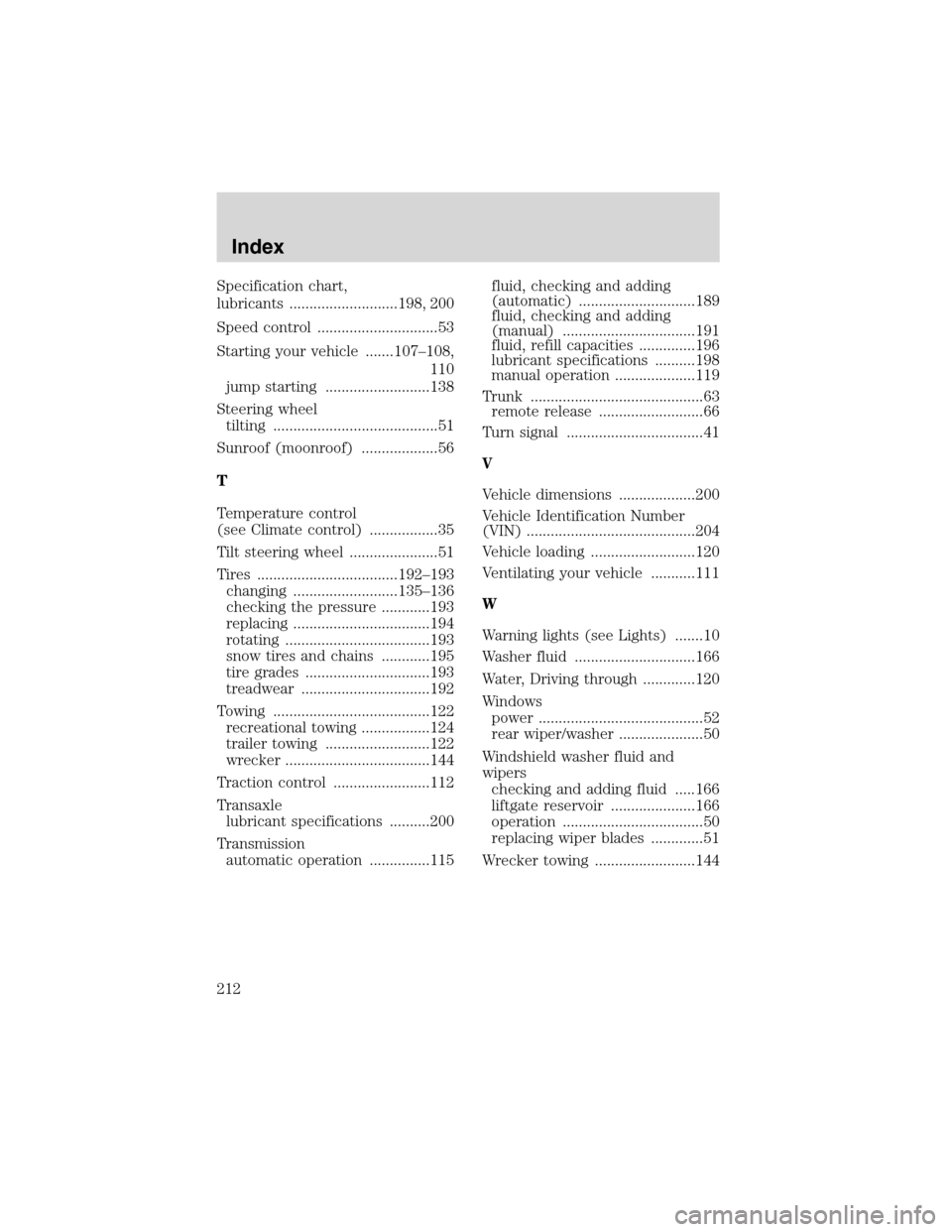2003 FORD FOCUS towing
[x] Cancel search: towingPage 144 of 216

WRECKER TOWING
If you need to have your vehicle towed, contact a professional towing
service or, if you are a member of a roadside assistance program, your
roadside assistance service provider.
It is recommended that your vehicle be towed with a wheel lift or flatbed
equipment. Do not tow with a slingbelt. Ford Motor Company has not
approved a slingbelt towing procedure.
If your vehicle is to be towed from the rear using wheel lift equipment,
the front wheels (drive wheels) must be placed on a dolly to prevent
damage to the transmission.
If the vehicle is towed by other means or incorrectly, vehicle
damage may occur.
Ford Motor Company produces a towing manual for all authorized tow
truck operators. Have your tow truck operator refer to this manual for
proper hook-up and towing procedures for your vehicle.
Roadside Emergencies
144
Page 147 of 216

In the United States, a warranty dispute must be submitted to the
Dispute Settlement Board before taking action under the Magnuson-Moss
Warranty Act, or to the extent allowed by state law, before pursuing
replacement or repurchase remedies provided by certain state laws. This
dispute handling procedure is not required prior to enforcing state
created rights or other rights which are independent of the
Magnuson-Moss Warranty Act or state replacement or repurchase laws.
FORD EXTENDED SERVICE PLAN
You can get more protection for your new car or light truck by
purchasing Ford Extended Service Plan (Ford ESP) coverage. Ford ESP
is an optional service contract which is backed by Ford Motor Company
or Ford Motor Service Company (in the U.S.) and Ford of Canada (in
Canada). It provides the following:
•Benefits during the warranty period depending on the plan you
purchase (such as: reimbursement for rentals; coverage for certain
maintenance and wear items).
•Protection against covered repair costs after your Bumper-to-Bumper
Warranty expires.
You may purchase Ford ESP from any participating Ford and Lincoln
Mercury and Ford of Canada dealer. There are several plans available in
various time, distance and deductible combinations which can be tailored
to fit your own driving needs. Ford ESP also offers reimbursement
benefits for towing and rental coverage.
When you buy Ford ESP, you receive Peace-of-Mind protection
throughout the United States and Canada, provided by a network of
more than 5,000 participating Ford or Lincoln Mercury and Ford of
Canada dealers.
If you did not take advantage of the Ford Extended Service Plan at the
time of purchasing your vehicle, you may still be eligible. Since this
information is subject to change, please ask your dealer for complete
details about Ford Extended Service Plan coverage options, or visit the
Ford ESP website at www.ford-esp.com.
THE DISPUTE SETTLEMENT BOARD (U.S. ONLY)
The Dispute Settlement Board is:
•an independent, third-party arbitration program for warranty disputes.
•available free to owners and lessees of qualifying Ford Motor Company
vehicles.
Customer Assistance
147
Page 184 of 216

Habits
•Smooth, moderate operation can yield up to 10% savings in fuel.
•Steady speeds without stopping will usually give the best fuel
economy.
•Idling for long periods of time (greater than one minute) may waste
fuel.
•Anticipate stopping; slowing down may eliminate the need to stop.
•Sudden or hard accelerations may reduce fuel economy.
•Slow down gradually.
•Driving at reasonable speeds (traveling at 88 km/h [55 mph] uses 15%
less fuel than traveling at 105 km/h [65 mph]).
•Revving the engine before turning it off may reduce fuel economy.
•Using the air conditioner or defroster may reduce fuel economy.
•You may want to turn off the speed control in hilly terrain if
unnecessary shifting between third and fourth gear occurs.
Unnecessary shifting of this type could result in reduced fuel
economy.
•Warming up a vehicle on cold mornings is not required and may
reduce fuel economy.
•Resting your foot on the brake pedal while driving may reduce fuel
economy.
•Combine errands and minimize stop-and-go driving.
Maintenance
•Keep tires properly inflated and use only recommended size.
•Operating a vehicle with the wheels out of alignment will reduce fuel
economy.
•Use recommended engine oil. Refer toLubricant specificationsin
this chapter.
•Perform all regularly scheduled maintenance items. Follow the
recommended maintenance schedule and owner maintenance checks
found in your vehicle scheduled maintenance guide.
Conditions
•Heavily loading a vehicle or towing a trailer may reduce fuel economy
at any speed.
•Carrying unnecessary weight may reduce fuel economy (approximately
0.4 km/L [1 mpg] is lost for every 180 kg [400 lb] of weight carried).
Maintenance and Specifications
184
Page 211 of 216

instrument panel, dimming .....39
interior lamps ...........................42
Lane change indicator
(see Turn signal) ........................41
Liftgate ........................................59
Lights, warning and indicator ....10
anti-lock brakes (ABS) ..........111
Load limits .................................120
GAWR ......................................120
GVWR ......................................120
trailer towing ..........................120
Locks
childproof ..................................63
Lubricant specifications ...198, 200
M
Manual transaxle
lubricant specifications ..........200
Manual transmission .................119
fluid capacities ........................196
reverse .....................................119
Mirrors .........................................53
side view mirrors (power) .......53
Moon roof ....................................56
Motorcraft parts ................182, 196
O
Octane rating ............................181
Oil (see Engine oil) ..................166
P
Parking brake ............................112
Parts (see Motorcraft parts) ....196
Power distribution box
(see Fuses) ...............................131Power steering ..........................115
fluid, checking and adding ....188
fluid, refill capacity ................196
fluid, specifications .........198, 200
Power Windows ...........................52
R
Rear window defroster ...............37
Relays ........................................127
Remote entry system .................65
locking/unlocking doors ...........62
opening the trunk .....................66
Roadside assistance ..................125
S
Safety Belt Maintenance ............88
Safety belts (see Safety
restraints) ........................76, 79–83
Safety defects, reporting ..........153
Safety restraints ..............76, 79–83
belt minder ...............................84
extension assembly ..................88
for adults .............................80–82
for children .........................95–96
safety belt maintenance ...........88
warning light and chime ..........84
Safety seats for children ............99
Seat belts (see Safety
restraints) ....................................76
Seats ............................................72
child safety seats ......................99
Servicing your vehicle ..............161
Spare tire (see Changing the
Tire) ...........................................135
Spark plugs,
specifications .....................196, 200
Index
211
Page 212 of 216

Specification chart,
lubricants ...........................198, 200
Speed control ..............................53
Starting your vehicle .......107–108,
110
jump starting ..........................138
Steering wheel
tilting .........................................51
Sunroof (moonroof) ...................56
T
Temperature control
(see Climate control) .................35
Tilt steering wheel ......................51
Tires ...................................192–193
changing ..........................135–136
checking the pressure ............193
replacing ..................................194
rotating ....................................193
snow tires and chains ............195
tire grades ...............................193
treadwear ................................192
Towing .......................................122
recreational towing .................124
trailer towing ..........................122
wrecker ....................................144
Traction control ........................112
Transaxle
lubricant specifications ..........200
Transmission
automatic operation ...............115fluid, checking and adding
(automatic) .............................189
fluid, checking and adding
(manual) .................................191
fluid, refill capacities ..............196
lubricant specifications ..........198
manual operation ....................119
Trunk ...........................................63
remote release ..........................66
Turn signal ..................................41
V
Vehicle dimensions ...................200
Vehicle Identification Number
(VIN) ..........................................204
Vehicle loading ..........................120
Ventilating your vehicle ...........111
W
Warning lights (see Lights) .......10
Washer fluid ..............................166
Water, Driving through .............120
Windows
power .........................................52
rear wiper/washer .....................50
Windshield washer fluid and
wipers
checking and adding fluid .....166
liftgate reservoir .....................166
operation ...................................50
replacing wiper blades .............51
Wrecker towing .........................144
Index
212